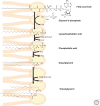Glycerolipid Synthesis and Lipid Droplet Formation in the Endoplasmic Reticulum
- PMID: 36096640
- PMCID: PMC10153804
- DOI: 10.1101/cshperspect.a041246
Glycerolipid Synthesis and Lipid Droplet Formation in the Endoplasmic Reticulum
Abstract
More than 60 years ago, Eugene Kennedy and coworkers elucidated the endoplasmic reticulum (ER)-based pathways of glycerolipid synthesis, including the synthesis of phospholipids and triacylglycerols (TGs). The reactions of the Kennedy pathway were identified by studying the conversion of lipid intermediates and the isolation of biochemical enzymatic activities, but the molecular basis for most of these reactions was unknown. With recent progress in the cell biology, biochemistry, and structural biology in this area, we have a much more mechanistic understanding of this pathway and its reactions. In this review, we provide an overview of molecular aspects of glycerolipid synthesis, focusing on recent insights into the synthesis of TGs. Further, we go beyond the Kennedy pathway to describe the mechanisms for storage of TG in cytosolic lipid droplets and discuss how overwhelming these pathways leads to ER stress and cellular toxicity, as seen in diseases linked to lipid overload and obesity.
Copyright © 2023 Cold Spring Harbor Laboratory Press; all rights reserved.
Figures



References
-
- Agarwal AK, Sukumaran S, Cortés VA, Tunison K, Mizrachi D, Sankella S, Gerard RD, Horton JD, Garg A. 2011. Human 1-acylglycerol-3-phosphate O-acyltransferase isoforms 1 and 2: biochemical characterization and inability to rescue hepatic steatosis in Agpat2−/− gene lipodystrophic mice. J Biol Chem 286: 37676–37691. 10.1074/jbc.M111.250449 - DOI - PMC - PubMed
Publication types
MeSH terms
Substances
Grants and funding
LinkOut - more resources
Full Text Sources
Miscellaneous
